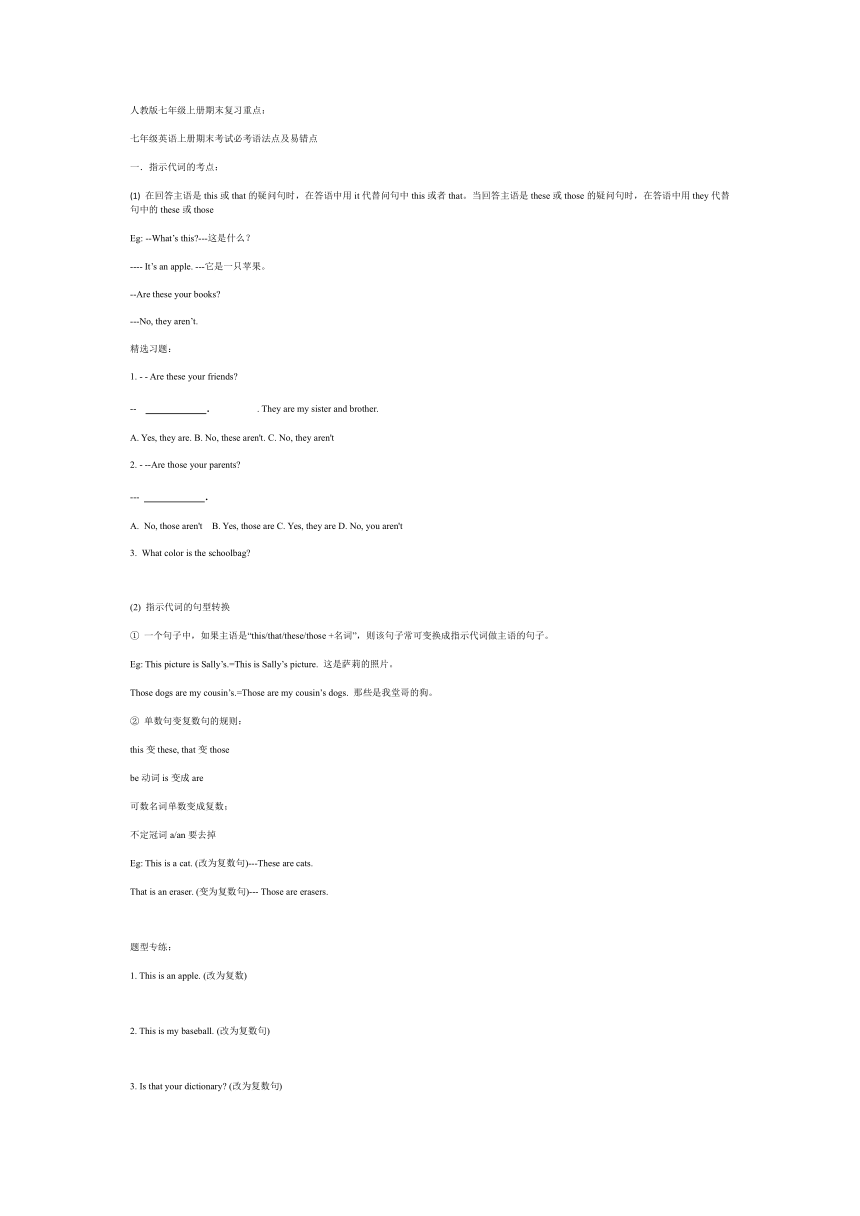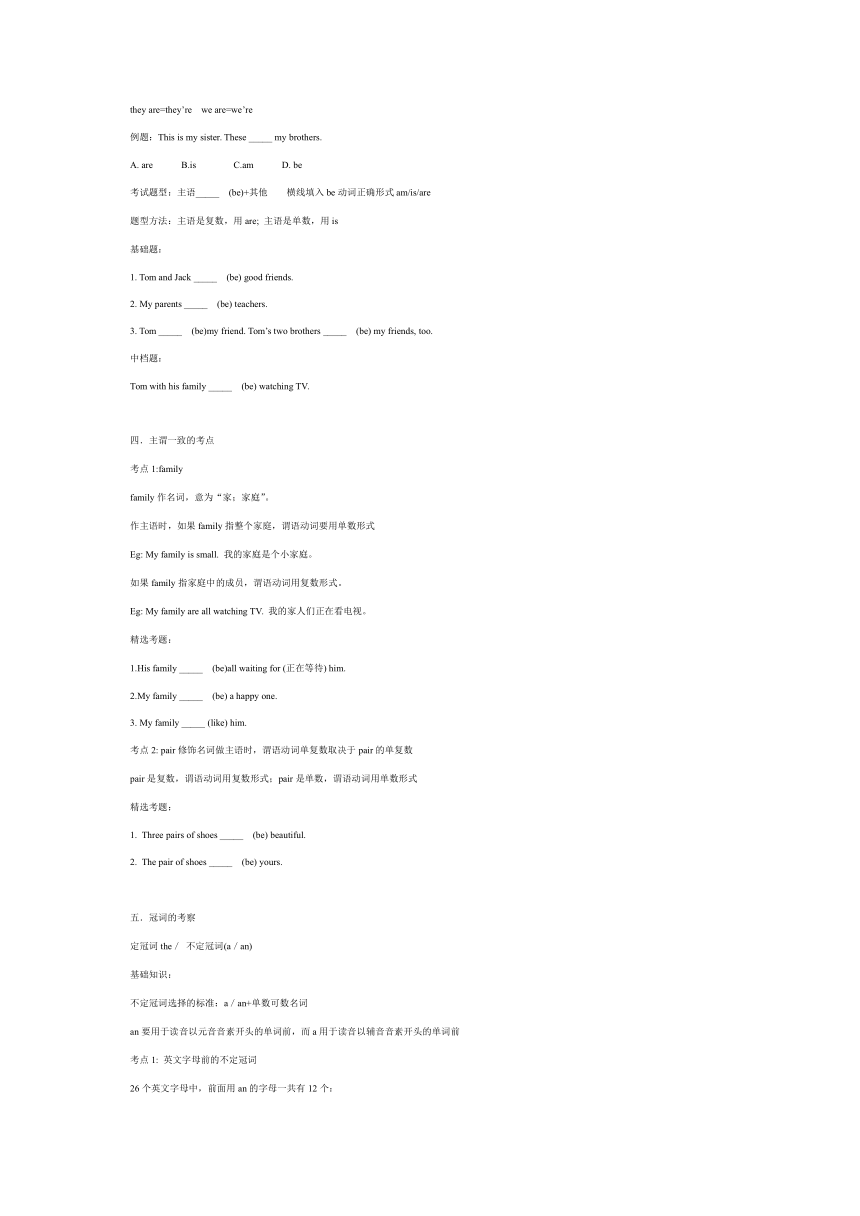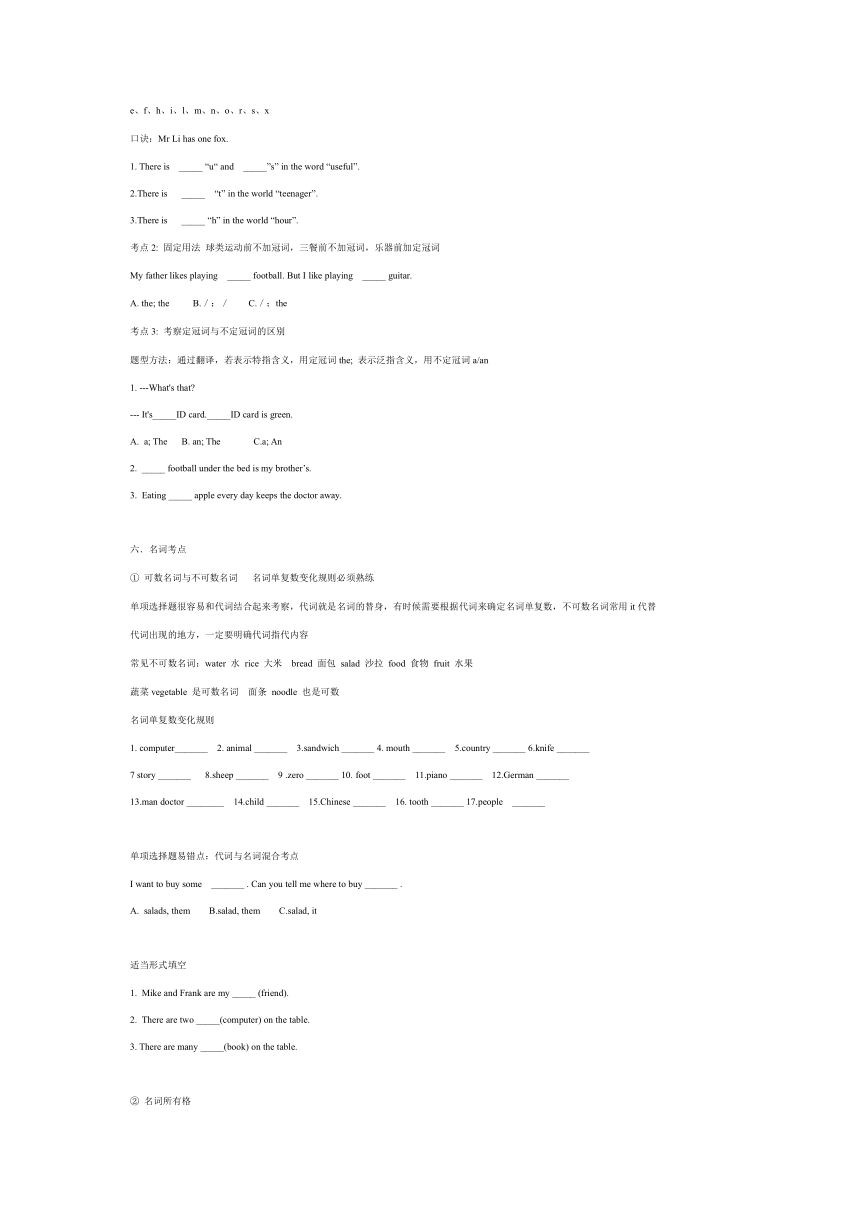2021-2022学年人教版七年级上册英语期末复习重点内容
文档属性
| 名称 | 2021-2022学年人教版七年级上册英语期末复习重点内容 |  | |
| 格式 | docx | ||
| 文件大小 | 29.6KB | ||
| 资源类型 | 教案 | ||
| 版本资源 | 人教新目标(Go for it)版 | ||
| 科目 | 英语 | ||
| 更新时间 | 2021-12-17 14:58:12 | ||
图片预览




文档简介
人教版七年级上册期末复习重点:
七年级英语上册期末考试必考语法点及易错点
一.指示代词的考点:
(1) 在回答主语是this或that的疑问句时,在答语中用it代替问句中this或者that。当回答主语是these或those的疑问句时,在答语中用they代替句中的these或those
Eg: --What’s this ---这是什么?
---- It’s an apple. ---它是一只苹果。
--Are these your books
---No, they aren’t.
精选习题:
1. - - Are these your friends
-- . . They are my sister and brother.
A. Yes, they are. B. No, these aren't. C. No, they aren't
2. - --Are those your parents
--- .
No, those aren't B. Yes, those are C. Yes, they are D. No, you aren't
What color is the schoolbag
(2) 指示代词的句型转换
① 一个句子中,如果主语是“this/that/these/those +名词”,则该句子常可变换成指示代词做主语的句子。
Eg: This picture is Sally’s.=This is Sally’s picture. 这是萨莉的照片。
Those dogs are my cousin’s.=Those are my cousin’s dogs. 那些是我堂哥的狗。
② 单数句变复数句的规则:
this变these, that变those
be动词is变成are
可数名词单数变成复数;
不定冠词a/an要去掉
Eg: This is a cat. (改为复数句)---These are cats.
That is an eraser. (变为复数句)--- Those are erasers.
题型专练:
1. This is an apple. (改为复数)
2. This is my baseball. (改为复数句)
3. Is that your dictionary (改为复数句)
4. That telephone is his. (改为同义句)
_____ is _____ telephone.
5. Are these dogs (作否定回答)
No, _____ _____ .
6. Are those jackets (改为单数句)
人称代词和物主代词的考点
核心思路:
翻译,不加“的”,句首用主格,动词或介词后用宾格
加“的”,后有名词,用形物代;无名词,用名物代
精选考题:
① 单项选择题
根据具体语境,选择合适的人称
Frank is _____ friend. _____ a good boy
my,His B. my, He’s C. I,He
② 用所给代词的正确形式填空。
These are_____ (he) brothers.
That is _____ (she) sister.
_____(I) father is a teacher.
Tom, this is_____ (me) cousin, Mary.
Do you know _____ (it) name
Thanks for helping_____(I).
My father and mother are teachers. are busy. (them).
8. Are these _____ (you) pencils Yes, they are (our).
9. --Whose is this pencil --It’s_____ (I).
10. _____(Ann) mother is _____ (we) teacher.
③ 选词填空题型
形容词物主代词+ _____,遇到此结构,填名词即可,然后考虑单复数问题
形容词物主代词+ _____+名词,遇到此结构,填形容词或序数词即可
_____+名词 遇到此结构,可能填形容词性物主代词
be动词的用法考点
am,is,are是be动词一般现在时共有的三种形式。
我(I)用am,你(you用are,is跟着他(he)她(she) 它 (it),单数is,复数are
he is =he’s you are=you’re she is =she’s it is =it’s
they are=they’re we are=we’re
例题:This is my sister. These _____ my brothers.
A. are B.is C.am D. be
考试题型:主语_____ (be)+其他 横线填入be动词正确形式am/is/are
题型方法:主语是复数,用are; 主语是单数,用is
基础题:
1. Tom and Jack _____ (be) good friends.
2. My parents _____ (be) teachers.
3. Tom _____ (be)my friend. Tom’s two brothers _____ (be) my friends, too.
中档题:
Tom with his family _____ (be) watching TV.
主谓一致的考点
考点1:family
family作名词,意为“家;家庭”。
作主语时,如果family指整个家庭,谓语动词要用单数形式
Eg: My family is small. 我的家庭是个小家庭。
如果family指家庭中的成员,谓语动词用复数形式。
Eg: My family are all watching TV. 我的家人们正在看电视。
精选考题:
1.His family _____ (be)all waiting for (正在等待) him.
2.My family _____ (be) a happy one.
3. My family _____ (like) him.
考点2: pair修饰名词做主语时,谓语动词单复数取决于pair的单复数
pair是复数,谓语动词用复数形式;pair是单数,谓语动词用单数形式
精选考题:
Three pairs of shoes _____ (be) beautiful.
The pair of shoes _____ (be) yours.
五.冠词的考察
定冠词the/ 不定冠词(a/an)
基础知识:
不定冠词选择的标准:a/an+单数可数名词
an要用于读音以元音音素开头的单词前,而a用于读音以辅音音素开头的单词前
考点1: 英文字母前的不定冠词
26个英文字母中,前面用an的字母一共有12个:
e、f、h、i、l、m、n、o、r、s、x
口诀:Mr Li has one fox.
1. There is _____ “u“ and _____”s” in the word “useful”.
2.There is _____ “t” in the world “teenager”.
3.There is _____ “h” in the world “hour”.
考点2: 固定用法 球类运动前不加冠词,三餐前不加冠词,乐器前加定冠词
My father likes playing _____ football. But I like playing _____ guitar.
A. the; the B./;/ C./;the
考点3: 考察定冠词与不定冠词的区别
题型方法:通过翻译,若表示特指含义,用定冠词the; 表示泛指含义,用不定冠词a/an
1. ---What's that
--- It's_____ID card._____ID card is green.
a; The B. an; The C.a; An
_____ football under the bed is my brother’s.
Eating _____ apple every day keeps the doctor away.
六.名词考点
① 可数名词与不可数名词 名词单复数变化规则必须熟练
单项选择题很容易和代词结合起来考察,代词就是名词的替身,有时候需要根据代词来确定名词单复数,不可数名词常用it代替
代词出现的地方,一定要明确代词指代内容
常见不可数名词:water 水 rice 大米 bread 面包 salad 沙拉 food 食物 fruit 水果
蔬菜vegetable 是可数名词 面条 noodle 也是可数
名词单复数变化规则
1. computer_______ 2. animal _______ 3.sandwich _______ 4. mouth _______ 5.country _______ 6.knife _______
7 story _______ 8.sheep _______ 9 .zero _______ 10. foot _______ 11.piano _______ 12.German _______
13.man doctor ________ 14.child _______ 15.Chinese _______ 16. tooth _______ 17.people _______
单项选择题易错点:代词与名词混合考点
I want to buy some _______ . Can you tell me where to buy _______ .
salads, them B.salad, them C.salad, it
适当形式填空
Mike and Frank are my _____ (friend).
There are two _____(computer) on the table.
3. There are many _____(book) on the table.
② 名词所有格
高频考点:
1. 表示两个人具有一个事物,在最后一个名词词尾加’s 。如:
Jim and Tom's room is not very big.
吉姆和汤姆的房间不是很大。(表示共有)
2.表示两个人各自所有,在每个名词词尾都加’s 。
Kale's and Jane's mothers are both teachers
凯特的母亲和简的母亲都是教师。(表示各自所有)
精选考题:
1. This is ______ bedroom. It’s tidy and nice.
A. Lily’s and Lucy’s B.Lily and Lucy’s
C. Lily’s and Lucy D. Lily and Lucy
2. _______ room is very nice.
A. Tom’s and John’s B. Tom’s and John C. Tom and John’s D. Tom and John
3. Tom和Jack各自的房间
适当形式填空:解题思路:通过翻译,看名词后面需要加“的”
精选考题:
1. These books are these _____ (child).
2. March 8th is _______Day. (woman).
3.The shop sells_______(妇女) handbags.
These are ______ (John) books.
It's an_______ (hour) ride from here to the museum.
时态一般现在时单项选择题考点:以下解题思路只适用于目前初一阶段
基础知识回顾:什么时候主语是第三人称单数形式?
从字面上理解,它包含两个意思:第三人称和单数
要知道第三人称必须先弄清楚第一人称和第二人称,第一人称也即是I和we, 第三人称是you, 除此以外的全是第三人称。
单数就是指1个
常见的第三人称单数:
he, she ,it
单个人名地名 比如:Mike, John
可数名词单数,比如:the desk, that ruler
不可数名词, 比如:milk, rice
精选习题:
1. She ____ (do) homework by herself.
2. Jack ____ (go) home by bike .
3. The sun ____ (rise) in the east.
4. Her mum _____ (get) up at 7 o’clock.
5. School _______ (start) at eight o’clock.
5. He ___(get)up at 7 every morning.
6. My father ___ (walk) to work every day.
7. Mike sometimes ___ (go) to the park with his sister.
① 一般疑问句与特殊疑问句考点:高频易错题
题型特征:句首无特殊疑问词的问句,如:_____ your mother (主语)+其他?
句首有特殊疑问词的问句,如:What _____ your mother (主语)+其他?
解题思路:① 找主语
②看主语后面,若主语后不是动词原型,则选择be动词(am/is/are)
主语之后是动词原型,则选择do/does,主语是第三人称单数,选择does;若不是,选择do
精选考题:
_____ Tom a student
_____ your mother often go to work on foot
What _____ your mother often do on weekends
_____ they often play football on weekends
5. _____ you often late
6. _____ these storybooks very interesting
② 一般现在时陈述句,下列方法仅适用于初一上册阶段
题型特征:主语 _____ (do)+其他。
解题思路:① 确定一般现在时
② 看主语,主语是第三人称单数,动词用第三人称单数形式;若是其他人称,用动词原型
精选考题:
Her mother often_____(go) to work on foot.
My brother and I _____ (study) in the same school.
John always_____(get) up early.
They often _____ (play) football after school.
My grandfather often _____ (run) in the morning.
题型特征:否定句:主语 _____ (not do)+其他。
解题思路:先看主语,主语是第三人称单数,则填doesn’t do;若不是,则填don’t do
精选习题:
1. My mother _____(not work) in the hospital.
2. He _____ (not study) in the middle school.
3. John _____(not like) playing football.
4. They often _____ (not go) swimming after-school.
5. My father often _____ (not read) newspapers in the morning.
八.七年级上册英语适当形式考察非谓语动词的考点
want to do sth 想要做某事 want sb to do sth 想要某人做某事 finish doing sth 完成做某事
like doing sth 喜欢做某事 need to do sth 需要做某事 ask sb to do sth 要求某人去做某事
be busy doing sth 忙于做某事 help sb do sth 帮助某人做某事
介词后跟动名词形式,初一常考表达:thank sb for doing sth 因做某事感谢某人 what about doing sth 做某事如何
let sb do sth 让某人做某事
补充: ask的用法 ask sb for sth 向某人寻求某物 ask for sth 征求某物
精选考题:
1. Thank the two children for _____(help) the old man cross the road.
2. What about _____(take)a bus to the supermarket
3. Let them _____ (go) with us. We can be friends.
4. My father likes _____ (read) books.
5. My teacher wants me _____ (learn) English well.
6. He wants _____ (watch) TV.
7. He is busy _____ (do) his homework.
八. 时间介词的考点
in/on/at:
(1)at 用于具体的时刻前,也可用于固定搭配中
固定搭配:at noon 在中午 at night 在晚上 at the beginning of```` 在···开始
at the end of ``` 在····结束 at the age of``` 在多少岁的时候
具体时刻:at seven at
(2)in用于世纪,年,月,季节,一段时间或泛指的一题的上午,下午,晚上等之前
in the sixteenth century 在16世纪 in autumn 在秋天 in the morning 在早上
(3)on主要用在星期几,具体某一天的早,中,晚或节日前
Eg: on Mid-Autumn Day 在中秋节 on June 1st 在6月1号
注意:在以this,that,next,last,tomorrow,yesterday,every等开始的表示时间的词或词组前不用加介词
题组训练:_____ noon _____ the end of the meeting _____ the morning of April 21 _____ a cold night in April _____ autumn
_____ his twenties _____ the twenty-first century _____ a quarter to ten _____ the age of twelve _____Mother’s day
九.特殊疑问词
初一学过的疑问词:when/what time对时间进行提问,what time对具体时刻;what color对颜色进行提问;how much对价格进行提问;where对地点进行提问
解题思路:考察疑问词辨析,看答语进行选择
_____ are the white shoes
--35 yuan.
_____ do you have art class
-- Every Monday.
-- _____ is that on your desk --- A red book.
A. What B. What color C. How much
七年级上册句型转换
(1) 否定句和一般疑问句
否定句变化口诀:在be动词(am/is/are)或can的后面加not; 如果没有be动词(am/is/are)或can,要在动词前面加don't或doesn't,主语是第三人称单数时要用doesn't,后面的动词要变原形,如果有some,要改any,如果有and,要改or.
一般疑问句变化口诀:
① 有be动词(am/is/are)或can,提置句首,一人称变二人称;
② 如果没有be动词(am/is/are)或can,要借助助动词do/does
主语是第三人称单数时,要将助动词does放在句首,后面的动词要变原形;其他人称借助do
注意:一人称变二人称如果有some,要改any,如果有and,要改or.
精选习题:
1. 他每天早上7点起床。
否定句:
一般疑问句问:
2. 他们每天骑自行车去学校。
否定句:
一般疑问句问:
2. 她每天晚上写作业。
否定句:
一般疑问句问:
3. 麦克每天早上洗澡。
否定句:
一般疑问句问:
4. 我们喜欢放风筝。
否定句:
一般疑问句问:
5. 我妈妈会说英语。
否定句:
一般疑问句问:
对划线部分提问
1. He goes swimming every day.
2. He often plays football every afternoon.
3. The book is ten yuan.
4. The cover of the book is red.
5. He likes apples.
七年级英语上册期末考试必考语法点及易错点
一.指示代词的考点:
(1) 在回答主语是this或that的疑问句时,在答语中用it代替问句中this或者that。当回答主语是these或those的疑问句时,在答语中用they代替句中的these或those
Eg: --What’s this ---这是什么?
---- It’s an apple. ---它是一只苹果。
--Are these your books
---No, they aren’t.
精选习题:
1. - - Are these your friends
-- . . They are my sister and brother.
A. Yes, they are. B. No, these aren't. C. No, they aren't
2. - --Are those your parents
--- .
No, those aren't B. Yes, those are C. Yes, they are D. No, you aren't
What color is the schoolbag
(2) 指示代词的句型转换
① 一个句子中,如果主语是“this/that/these/those +名词”,则该句子常可变换成指示代词做主语的句子。
Eg: This picture is Sally’s.=This is Sally’s picture. 这是萨莉的照片。
Those dogs are my cousin’s.=Those are my cousin’s dogs. 那些是我堂哥的狗。
② 单数句变复数句的规则:
this变these, that变those
be动词is变成are
可数名词单数变成复数;
不定冠词a/an要去掉
Eg: This is a cat. (改为复数句)---These are cats.
That is an eraser. (变为复数句)--- Those are erasers.
题型专练:
1. This is an apple. (改为复数)
2. This is my baseball. (改为复数句)
3. Is that your dictionary (改为复数句)
4. That telephone is his. (改为同义句)
_____ is _____ telephone.
5. Are these dogs (作否定回答)
No, _____ _____ .
6. Are those jackets (改为单数句)
人称代词和物主代词的考点
核心思路:
翻译,不加“的”,句首用主格,动词或介词后用宾格
加“的”,后有名词,用形物代;无名词,用名物代
精选考题:
① 单项选择题
根据具体语境,选择合适的人称
Frank is _____ friend. _____ a good boy
my,His B. my, He’s C. I,He
② 用所给代词的正确形式填空。
These are_____ (he) brothers.
That is _____ (she) sister.
_____(I) father is a teacher.
Tom, this is_____ (me) cousin, Mary.
Do you know _____ (it) name
Thanks for helping_____(I).
My father and mother are teachers. are busy. (them).
8. Are these _____ (you) pencils Yes, they are (our).
9. --Whose is this pencil --It’s_____ (I).
10. _____(Ann) mother is _____ (we) teacher.
③ 选词填空题型
形容词物主代词+ _____,遇到此结构,填名词即可,然后考虑单复数问题
形容词物主代词+ _____+名词,遇到此结构,填形容词或序数词即可
_____+名词 遇到此结构,可能填形容词性物主代词
be动词的用法考点
am,is,are是be动词一般现在时共有的三种形式。
我(I)用am,你(you用are,is跟着他(he)她(she) 它 (it),单数is,复数are
he is =he’s you are=you’re she is =she’s it is =it’s
they are=they’re we are=we’re
例题:This is my sister. These _____ my brothers.
A. are B.is C.am D. be
考试题型:主语_____ (be)+其他 横线填入be动词正确形式am/is/are
题型方法:主语是复数,用are; 主语是单数,用is
基础题:
1. Tom and Jack _____ (be) good friends.
2. My parents _____ (be) teachers.
3. Tom _____ (be)my friend. Tom’s two brothers _____ (be) my friends, too.
中档题:
Tom with his family _____ (be) watching TV.
主谓一致的考点
考点1:family
family作名词,意为“家;家庭”。
作主语时,如果family指整个家庭,谓语动词要用单数形式
Eg: My family is small. 我的家庭是个小家庭。
如果family指家庭中的成员,谓语动词用复数形式。
Eg: My family are all watching TV. 我的家人们正在看电视。
精选考题:
1.His family _____ (be)all waiting for (正在等待) him.
2.My family _____ (be) a happy one.
3. My family _____ (like) him.
考点2: pair修饰名词做主语时,谓语动词单复数取决于pair的单复数
pair是复数,谓语动词用复数形式;pair是单数,谓语动词用单数形式
精选考题:
Three pairs of shoes _____ (be) beautiful.
The pair of shoes _____ (be) yours.
五.冠词的考察
定冠词the/ 不定冠词(a/an)
基础知识:
不定冠词选择的标准:a/an+单数可数名词
an要用于读音以元音音素开头的单词前,而a用于读音以辅音音素开头的单词前
考点1: 英文字母前的不定冠词
26个英文字母中,前面用an的字母一共有12个:
e、f、h、i、l、m、n、o、r、s、x
口诀:Mr Li has one fox.
1. There is _____ “u“ and _____”s” in the word “useful”.
2.There is _____ “t” in the world “teenager”.
3.There is _____ “h” in the world “hour”.
考点2: 固定用法 球类运动前不加冠词,三餐前不加冠词,乐器前加定冠词
My father likes playing _____ football. But I like playing _____ guitar.
A. the; the B./;/ C./;the
考点3: 考察定冠词与不定冠词的区别
题型方法:通过翻译,若表示特指含义,用定冠词the; 表示泛指含义,用不定冠词a/an
1. ---What's that
--- It's_____ID card._____ID card is green.
a; The B. an; The C.a; An
_____ football under the bed is my brother’s.
Eating _____ apple every day keeps the doctor away.
六.名词考点
① 可数名词与不可数名词 名词单复数变化规则必须熟练
单项选择题很容易和代词结合起来考察,代词就是名词的替身,有时候需要根据代词来确定名词单复数,不可数名词常用it代替
代词出现的地方,一定要明确代词指代内容
常见不可数名词:water 水 rice 大米 bread 面包 salad 沙拉 food 食物 fruit 水果
蔬菜vegetable 是可数名词 面条 noodle 也是可数
名词单复数变化规则
1. computer_______ 2. animal _______ 3.sandwich _______ 4. mouth _______ 5.country _______ 6.knife _______
7 story _______ 8.sheep _______ 9 .zero _______ 10. foot _______ 11.piano _______ 12.German _______
13.man doctor ________ 14.child _______ 15.Chinese _______ 16. tooth _______ 17.people _______
单项选择题易错点:代词与名词混合考点
I want to buy some _______ . Can you tell me where to buy _______ .
salads, them B.salad, them C.salad, it
适当形式填空
Mike and Frank are my _____ (friend).
There are two _____(computer) on the table.
3. There are many _____(book) on the table.
② 名词所有格
高频考点:
1. 表示两个人具有一个事物,在最后一个名词词尾加’s 。如:
Jim and Tom's room is not very big.
吉姆和汤姆的房间不是很大。(表示共有)
2.表示两个人各自所有,在每个名词词尾都加’s 。
Kale's and Jane's mothers are both teachers
凯特的母亲和简的母亲都是教师。(表示各自所有)
精选考题:
1. This is ______ bedroom. It’s tidy and nice.
A. Lily’s and Lucy’s B.Lily and Lucy’s
C. Lily’s and Lucy D. Lily and Lucy
2. _______ room is very nice.
A. Tom’s and John’s B. Tom’s and John C. Tom and John’s D. Tom and John
3. Tom和Jack各自的房间
适当形式填空:解题思路:通过翻译,看名词后面需要加“的”
精选考题:
1. These books are these _____ (child).
2. March 8th is _______Day. (woman).
3.The shop sells_______(妇女) handbags.
These are ______ (John) books.
It's an_______ (hour) ride from here to the museum.
时态一般现在时单项选择题考点:以下解题思路只适用于目前初一阶段
基础知识回顾:什么时候主语是第三人称单数形式?
从字面上理解,它包含两个意思:第三人称和单数
要知道第三人称必须先弄清楚第一人称和第二人称,第一人称也即是I和we, 第三人称是you, 除此以外的全是第三人称。
单数就是指1个
常见的第三人称单数:
he, she ,it
单个人名地名 比如:Mike, John
可数名词单数,比如:the desk, that ruler
不可数名词, 比如:milk, rice
精选习题:
1. She ____ (do) homework by herself.
2. Jack ____ (go) home by bike .
3. The sun ____ (rise) in the east.
4. Her mum _____ (get) up at 7 o’clock.
5. School _______ (start) at eight o’clock.
5. He ___(get)up at 7 every morning.
6. My father ___ (walk) to work every day.
7. Mike sometimes ___ (go) to the park with his sister.
① 一般疑问句与特殊疑问句考点:高频易错题
题型特征:句首无特殊疑问词的问句,如:_____ your mother (主语)+其他?
句首有特殊疑问词的问句,如:What _____ your mother (主语)+其他?
解题思路:① 找主语
②看主语后面,若主语后不是动词原型,则选择be动词(am/is/are)
主语之后是动词原型,则选择do/does,主语是第三人称单数,选择does;若不是,选择do
精选考题:
_____ Tom a student
_____ your mother often go to work on foot
What _____ your mother often do on weekends
_____ they often play football on weekends
5. _____ you often late
6. _____ these storybooks very interesting
② 一般现在时陈述句,下列方法仅适用于初一上册阶段
题型特征:主语 _____ (do)+其他。
解题思路:① 确定一般现在时
② 看主语,主语是第三人称单数,动词用第三人称单数形式;若是其他人称,用动词原型
精选考题:
Her mother often_____(go) to work on foot.
My brother and I _____ (study) in the same school.
John always_____(get) up early.
They often _____ (play) football after school.
My grandfather often _____ (run) in the morning.
题型特征:否定句:主语 _____ (not do)+其他。
解题思路:先看主语,主语是第三人称单数,则填doesn’t do;若不是,则填don’t do
精选习题:
1. My mother _____(not work) in the hospital.
2. He _____ (not study) in the middle school.
3. John _____(not like) playing football.
4. They often _____ (not go) swimming after-school.
5. My father often _____ (not read) newspapers in the morning.
八.七年级上册英语适当形式考察非谓语动词的考点
want to do sth 想要做某事 want sb to do sth 想要某人做某事 finish doing sth 完成做某事
like doing sth 喜欢做某事 need to do sth 需要做某事 ask sb to do sth 要求某人去做某事
be busy doing sth 忙于做某事 help sb do sth 帮助某人做某事
介词后跟动名词形式,初一常考表达:thank sb for doing sth 因做某事感谢某人 what about doing sth 做某事如何
let sb do sth 让某人做某事
补充: ask的用法 ask sb for sth 向某人寻求某物 ask for sth 征求某物
精选考题:
1. Thank the two children for _____(help) the old man cross the road.
2. What about _____(take)a bus to the supermarket
3. Let them _____ (go) with us. We can be friends.
4. My father likes _____ (read) books.
5. My teacher wants me _____ (learn) English well.
6. He wants _____ (watch) TV.
7. He is busy _____ (do) his homework.
八. 时间介词的考点
in/on/at:
(1)at 用于具体的时刻前,也可用于固定搭配中
固定搭配:at noon 在中午 at night 在晚上 at the beginning of```` 在···开始
at the end of ``` 在····结束 at the age of``` 在多少岁的时候
具体时刻:at seven at
(2)in用于世纪,年,月,季节,一段时间或泛指的一题的上午,下午,晚上等之前
in the sixteenth century 在16世纪 in autumn 在秋天 in the morning 在早上
(3)on主要用在星期几,具体某一天的早,中,晚或节日前
Eg: on Mid-Autumn Day 在中秋节 on June 1st 在6月1号
注意:在以this,that,next,last,tomorrow,yesterday,every等开始的表示时间的词或词组前不用加介词
题组训练:_____ noon _____ the end of the meeting _____ the morning of April 21 _____ a cold night in April _____ autumn
_____ his twenties _____ the twenty-first century _____ a quarter to ten _____ the age of twelve _____Mother’s day
九.特殊疑问词
初一学过的疑问词:when/what time对时间进行提问,what time对具体时刻;what color对颜色进行提问;how much对价格进行提问;where对地点进行提问
解题思路:考察疑问词辨析,看答语进行选择
_____ are the white shoes
--35 yuan.
_____ do you have art class
-- Every Monday.
-- _____ is that on your desk --- A red book.
A. What B. What color C. How much
七年级上册句型转换
(1) 否定句和一般疑问句
否定句变化口诀:在be动词(am/is/are)或can的后面加not; 如果没有be动词(am/is/are)或can,要在动词前面加don't或doesn't,主语是第三人称单数时要用doesn't,后面的动词要变原形,如果有some,要改any,如果有and,要改or.
一般疑问句变化口诀:
① 有be动词(am/is/are)或can,提置句首,一人称变二人称;
② 如果没有be动词(am/is/are)或can,要借助助动词do/does
主语是第三人称单数时,要将助动词does放在句首,后面的动词要变原形;其他人称借助do
注意:一人称变二人称如果有some,要改any,如果有and,要改or.
精选习题:
1. 他每天早上7点起床。
否定句:
一般疑问句问:
2. 他们每天骑自行车去学校。
否定句:
一般疑问句问:
2. 她每天晚上写作业。
否定句:
一般疑问句问:
3. 麦克每天早上洗澡。
否定句:
一般疑问句问:
4. 我们喜欢放风筝。
否定句:
一般疑问句问:
5. 我妈妈会说英语。
否定句:
一般疑问句问:
对划线部分提问
1. He goes swimming every day.
2. He often plays football every afternoon.
3. The book is ten yuan.
4. The cover of the book is red.
5. He likes apples.
同课章节目录
